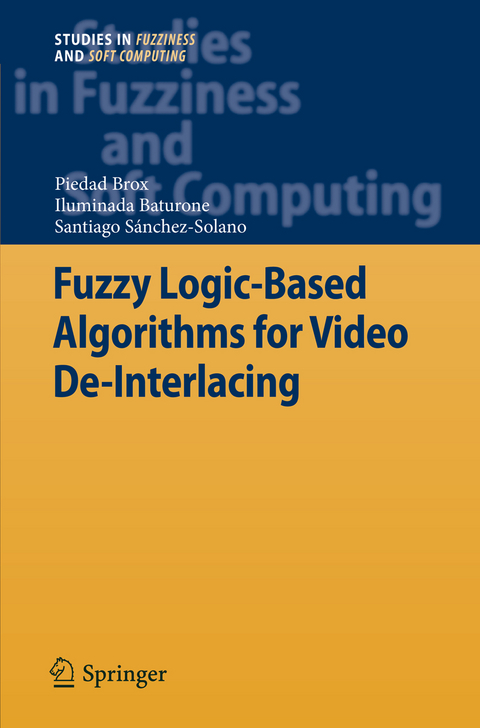
Fuzzy Logic-Based Algorithms for Video De-Interlacing
Seiten
2012
Springer Berlin (Verlag)
9783642262623 (ISBN)
Springer Berlin (Verlag)
9783642262623 (ISBN)
Researchers of the "Fuzzy Logic" group at the Microelectronics Institute of Seville have been studying fuzzy logic since the early 1990s. This book, borne of their efforts, covers the state-of-the-art of fuzzy logic-based algorithms for video de-interlacing.
The 'Fuzzy Logic' research group of the Microelectronics Institute of Seville is composed of researchers who have been doing research on fuzzy logic since the beginning of the 1990s. Mainly, this research has been focused on the microel- tronic design of fuzzy logic-based systems using implementation techniques which range from ASICs to FPGAs and DSPs. Another active line was the development of a CAD environment, named Xfuzzy, to ease such design. Several versions of Xfuzzy have been and are being currently developed by the group. The addressed applications had basically belonged to the control ?eld domain. In this sense, s- eral problems without a linear control solution had been studied thoroughly. Some examples are the navigation control of an autonomous mobile robot and the level control of a dosage system. The research group tackles a new activity with the work developed in this book: the application of fuzzy logic to video and image processing. We addressed our interest to problems related to pixel interpolation, with the aim of adapting such interpolation to the local features of the images. Our hypothesis was that measures and decisions to solve image interpolation, which traditionally had been done in a crisp way, could better be done in a fuzzy way. Validation of this general hypothesis has been done speci?cally in the interpolation problem of video de-interlacing. - interlacing is one of the main tasks in video processing.
The 'Fuzzy Logic' research group of the Microelectronics Institute of Seville is composed of researchers who have been doing research on fuzzy logic since the beginning of the 1990s. Mainly, this research has been focused on the microel- tronic design of fuzzy logic-based systems using implementation techniques which range from ASICs to FPGAs and DSPs. Another active line was the development of a CAD environment, named Xfuzzy, to ease such design. Several versions of Xfuzzy have been and are being currently developed by the group. The addressed applications had basically belonged to the control ?eld domain. In this sense, s- eral problems without a linear control solution had been studied thoroughly. Some examples are the navigation control of an autonomous mobile robot and the level control of a dosage system. The research group tackles a new activity with the work developed in this book: the application of fuzzy logic to video and image processing. We addressed our interest to problems related to pixel interpolation, with the aim of adapting such interpolation to the local features of the images. Our hypothesis was that measures and decisions to solve image interpolation, which traditionally had been done in a crisp way, could better be done in a fuzzy way. Validation of this general hypothesis has been done speci?cally in the interpolation problem of video de-interlacing. - interlacing is one of the main tasks in video processing.
Basic Concepts.- Fuzzy Motion-Adaptive Algorithm for Video De-interlacing.- Design Options of the Fuzzy Motion-Adaptive Algorithm.- Fuzzy Motion-Adaptive De-interlacing with Edge-Adaptive Spatial Interpolation.- Fuzzy Motion-Adaptive De-interlacing with Smart Temporal Interpolation.
| Erscheint lt. Verlag | 4.5.2012 |
|---|---|
| Reihe/Serie | Studies in Fuzziness and Soft Computing |
| Zusatzinfo | X, 174 p. |
| Verlagsort | Berlin |
| Sprache | englisch |
| Maße | 155 x 235 mm |
| Gewicht | 287 g |
| Themenwelt | Informatik ► Grafik / Design ► Digitale Bildverarbeitung |
| Informatik ► Theorie / Studium ► Künstliche Intelligenz / Robotik | |
| Technik ► Nachrichtentechnik | |
| Schlagworte | Digital video processing • edge adaptation • fuzzy inference systems • Fuzzy Logic • Interpolation • motion adaptation • picture-repetition adaptation • video de-interlacing |
| ISBN-13 | 9783642262623 / 9783642262623 |
| Zustand | Neuware |
| Informationen gemäß Produktsicherheitsverordnung (GPSR) | |
| Haben Sie eine Frage zum Produkt? |
Mehr entdecken
aus dem Bereich
aus dem Bereich
Methoden, Konzepte und Algorithmen in der Optotechnik, optischen …
Buch | Hardcover (2024)
Hanser (Verlag)
CHF 55,95


